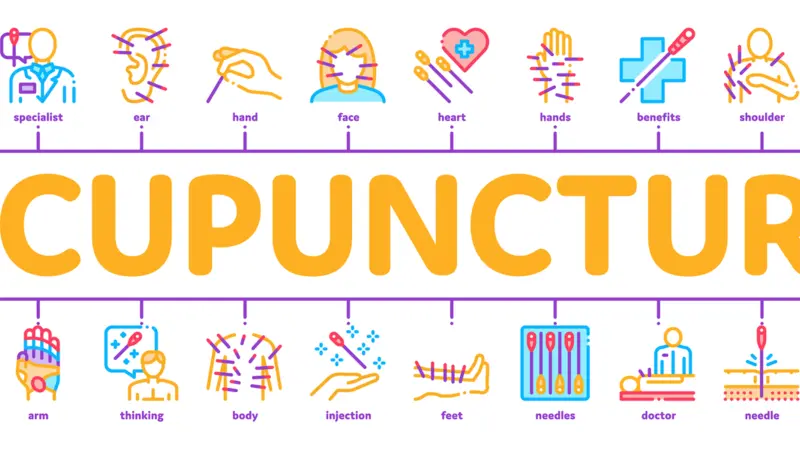

Integrative Health and Wellness

Integrative Health and Wellness
Acupuncture: An Overview of Scientific Evidence
Research into acupuncture as a medical treatment has grown exponentially in the past 20 years, increasing at twice the rate of research into conventional biomedicine. Over this period, there have been over 13,000 studies conducted in 60 countries, including hundreds of meta-analyses summarizing the results of thousands of human and animal studies.1 A wide variety of clinical areas have been studied, including pain, cancer, pregnancy, stroke, mood disorders, sleep disorders, and inflammation, to name a few.
Summarizing Acupuncture’s Evidence
With nearly 1,000 systematic reviews of acupuncture, getting a sense of what the evidence shows can be a challenge. Fortunately, the entire literature base was summarized in 2010 by the Australian Department of Veteran Affairs. This review was updated in 2014 by the US Department of Veteran Affairs2 and then again in 2017 by John McDonald and Stephen Janz, the authors of the Acupuncture Evidence Project. 3
“It is no longer possible to say that the effectiveness of acupuncture can be attributed to the placebo effect or that it is useful only for musculoskeletal pain.” Stephen Janz (2017)3
The Acupuncture Evidence Project reviewed the effectiveness of acupuncture for 122 treatments over 14 clinical areas. They found some evidence of effect for 117 conditions. “Our study found evidence for the effectiveness of acupuncture for 117 conditions, with stronger evidence for acupuncture’s effectiveness for some conditions than others. Acupuncture is considered safe in the hands of a well-trained practitioner and has been found to be cost-effective for some conditions. The quality and quantity of research into acupuncture’s effectiveness is increasing.” Acupuncture Evidence Project, p55
Medical Guideline Recommendations for Acupuncture
While acupuncture enjoys high-level clinical evidence for dozens of conditions, translating trial research into official medical guidelines can take time. However, a recent review examined clinical guideline recommendations from around the world made by a variety of groups including government health institutions, national guidelines, and medical specialty groups. Over a 27-year period, they found 2189 positive recommendations for acupuncture for 204 health problems, mainly in guidelines published in North America, Europe, and Australasia.4 These official recommendations indicate that acupuncture’s evidence is now acknowledged by medical experts and that acupuncture is no longer “alternative.” Indeed, this new data illustrates that acupuncture is one of the most widely recommended treatments in modern medicine.
Putting Acupuncture in Context: Evidence for Other Conditions
Acupuncture enjoys a high level of evidence for a variety of conditions. However, it can be challenging to understand the significance of this without comparison to the evidence for other commonly recommended treatments.
Looking at the evidence for currently recommended biomedical treatments, a recent review published in the proceedings of the Mayo Clinic in 2013 found that studies that examined the evidence for the standard of care (i.e., what doctors usually prescribe) recommended against current practice 46% of the time. In other words, from 2001-2010, for nearly half of the evaluated interventions, 146 in total, the recommendation to treat patients with these interventions was reversed.5 Another recent review also found that only about half of standard treatments were evidence-based: “An empirical evaluation of the Cochrane Database of Systematic Reviews found that the existing evidence base was unable to support or refute 49% of interventions, and 48% of American College of Cardiology recommendations were supported by expert opinion only.”6 In short, nearly half of all medical practices do not have positive evidence for their use and are not considered to fall into the category of “evidence-based medicine.”
Related to treatments that lack evidence, the overuse of medical interventions, defined as “the provision of medical services that are more likely to cause harm than good,” is also a global problem. “A more recent systematic review of global overuse categorized 83 overused or low-value services from studies including large sample sizes (more than 800 patients). These authors identified studies from four countries (with US studies predominating) and found that rates of overuse of various services ranged from about 1 to 80 percent.”7 These included treatments such as traction for patients with low-back pain and testing such as tumor marking studies for patients with previous breast cancer.
Acupuncture Head-to-Head
Using a review method known as a Network Meta-analysis, it is possible to evaluate various treatments for the same condition in a head-to-head analysis. Below are a few examples of how acupuncture compares to other treatments.
- A 2013 network meta-analysis comparing physical treatments for osteoarthritis of the knee found that, when looking at high-quality studies, acupuncture had the largest effect compared to usual care out of the conditions evaluated, out-performing exercise, sham acupuncture, and weight loss.9
- A 2015 network meta-analysis comparing treatments in addition to exercise for shoulder impingement syndrome found that acupuncture was the most effective adjunctive treatment out of 17 interventions, outperforming all other adjuncts such as steroid injection, NSAIDs, and ultrasound therapy.10
- A 2016 comparison of 20 treatments for sciatica ranked acupuncture as second most effective after the use of biological agents, outperforming manipulation, epidurals, disc surgery, opioids, exercise, and an invasive procedure called radiofrequency denervation, which came in last.11
- In 2018, a network meta-analysis found that acupuncture was more effective than drugs for treating chronic constipation and with the fewest side effects.12
How Does Acupuncture Work? A Look at Some Mechanisms
The mechanisms underlying how acupuncture relieves pain have been extensively researched for over 60 years. Sensory nerve pathways involving specialized nerve fibers (Aδ, Aβ and C, to be precise) and descending nervous system pathways have been mapped. Numerous biochemicals have been identified including opioid and non-opioid neuropeptides, and neurotransmitters such as serotonin, norepinephrine, dopamine, cytokines, glutamate, nitric oxide, and gamma-amino-butyric-acid (GABA). Acupuncture analgesia has been shown to involve several classes of naturally produced opioid neuropeptides including enkephalins, endorphins, dynorphins, endomorphins, and nociceptin (also known as Orphanin FQ). Among the non-opioid neuropeptides, substance P (SP), vasoactive intestinal peptide (VIP), and calcitonin generelated peptide (CGRP), which plays a central role in the pathogenesis of migraine, have been investigated for their roles in both the analgesic and anti-inflammatory effects of acupuncture.3, 13
Many biochemical and signaling pathways have been identified as playing a direct role in how acupuncture achieves its clinical effects, but perhaps the most central pathway that acupuncture uses, one that helps explain how it is effective in such a diverse array of clinical areas, is that acupuncture has been demonstrated to directly initiate a process called purinergic signaling, a primitive14 and ubiquitous system in the body using adenosine and ATP for signaling and regulation in all tissues and organ systems.15 It is now understood that all nerve transmission requires ATP as a co-factor and that the body uses purine levels as a primary background signal of both healthy function and tissue damage. Studies on mice demonstrate that those that were bred to be unable to bind to adenosine did not have pain relief from acupuncture nor any of the chemical changes associated with acupuncture pain relief, while the normal mice did16,17 and this effect was repeated in humans.18
Purinergic signaling has been demonstrated to play a central role in such diverse clinical areas as migraines and headaches,19 immune dysfunction and inflammation,20 cancer,21 autism,22 Alzheimer’s,23 cardiovascular disease,24,25, endocrine function26, embryological development27. While pharmaceutical companies are currently attempting to develop drugs in all of these areas to inhibit or enhance purinergic signaling,28 safety is an issue as the balance of these compounds at the cellular level is delicate, and both too much and too little adenosine and ATP are associated with disease. However, stimulating improved self-regulation of purinergic signaling through acupuncture treatment is likely both effective and safe.
In addition to biochemical actions, studies also demonstrate direct effects of acupuncture on the central nervous system. These include spinal reflex effects, where acupuncture stimulates muscle relaxation and changes in visceral organs. In the brain, acupuncture has been shown to change functional connectivity, decreasing activity in limbic structures associated with stress and illness while improving the regulation of the hypothalamus, pituitary, adrenal axis, the primary system that the body uses for regulating hormones and the physiological stress response.31 Additionally, acupuncture modulates parasympathetic activity, the branch of the nervous system associated with rest, relaxation, digestion, and tissue healing.32
Reporting Bias in Medical Research: A Global Problem
Some critics who deny acupuncture’s effectiveness despite considerable evidence to the contrary try to make the case that research coming from China should be discarded from reviews. While this would be contrary to standards set by the Cochrane Collaboration, considered to be the foremost global authority on review methodology, these critics say that China only publishes positive studies, also known as “reporting bias,” using a 1998 study as evidence.29 Most research into acupuncture is conducted outside of China, but China does produce a large number of studies each year.1 While there is at times evidence of methodological issues in research coming out of China, in order for the argument against Chinese studies to be valid, there would need to be evidence that these methodological issues are limited to China or are considerably worse there. But does such evidence exist? Is research from China suspect, yet trustworthy if conducted elsewhere?
The question of the role of publication country on the quality of research was looked at recently. A 2017 review published in the Journal of Clinical Epidemiology that compared methodological and reporting quality of systematic reviews from China and the USA found that the quality was the same in both countries. However, when it comes to reporting bias, reviews show that the practice is common world-wide and not at all limited to China or any country in particular.
A recent review found that the quality and reporting in systematic reviews, the highest level of medical evidence, is the same in the United States and China.
A review of reporting bias in medical research found that this issue is highly prevalent worldwide. “Results of clinical research are largely underreported or reported with delay. Various analyses of research protocols submitted to institutional review boards and research ethics committees in Europe, the United States, and Australia found that on average, only about half of the protocols had been published.”30
In the United States, the US Food and Drug Administration (FDA) approves new drugs based on trials submitted by the pharmaceutical companies who sell them. However, a review looking at 909 trials supporting 90 FDA-approved drugs found that fewer than half of the research had been published. Not surprisingly, studies were far more likely to be published if they were considered to be “pivotal” to the drug’s acceptance and if they showed a positive result.31
Another important review measuring the impact of reporting bias found that the problem was “widespread in the medical literature.” They found evidence of reporting bias for 40 clinical indications for about 50 different pharmacological, surgical, diagnostic, and vaccine interventions. “Many cases involved the withholding of study data by manufacturers and regulatory agencies, or the active attempt by manufacturers to suppress publication. The ascertained effects of reporting bias included the overestimation of efficacy and the underestimation of safety risks of interventions.”30
Improvements to this problem of unreliable evidence due to industry violations do not appear to be in progress. According to a 2017 appeal published in the British Medical Journal in response to “systematic bias, wastage, error and fraud in research underpinning patient care,” between 2009 and 2014, the drug industry received fines of $13 billion for criminal behavior and civil infringements, and yet systematic changes preventing these fraudulent behaviors and doctoring of data have been lacking.32
Conclusion
Acupuncture enjoys moderate-to-strong evidence of effectiveness in the treatment of 46 conditions and is considered safe in the hands of properly trained practitioners. This strong scientific support is impressive and helpful for patients in the context of a conventional healthcare system where nearly half of all treatments lack evidence for their use. Acupuncture is also considered cost effective for a number of conditions where evidence is available. Comparatively, for many conditions it enjoys greater evidence than many conventional treatments and is relatively safer. Patients, medical professionals, and healthcare administrators can be confident that the recommendation of acupuncture for many patients is a safe, cost-effective, and evidence-based recommendation.
REFERENCES
1. Ma Y, Dong M, Zhou K, et al. Publication Trends in Acupuncture Research: A 20-Year Bibliometric Analysis Based on PubMed. PLoS ONE 2016;11:e0168123. doi:10.1371/journal.pone.0168123
2. Hempel S, Taylor SL, Solloway MR, et al. Evidence Map of Acupuncture. Washington (DC): : Department of Veterans Affairs 2014.
3. The Acupuncture Evidence Project – A Comparative Literature Review 2017 – Acupuncture.org.au. 2017;:1–81.http://www.acupuncture.org.au/OURSERVICES/Publications/ AcupunctureEvidenceProject.aspx
4. Birch S, Lee MS, Alraek T, et al. Overview of Treatment Guidelines and Clinical Practical Guidelines That Recommend the Use of Acupuncture: A Bibliometric Analysis. The Journal of Alternative and Complementary Medicine Published Online First: 18 June 2018. doi:10.1089/acm.2018.0092
5. Prasad V, Vandross A, Toomey C, et al. A decade of reversal: an analysis of 146 contradicted medical practices. Mayo Clinic Proceedings 2013;88:790–8. doi:10.1016/j.mayocp.2013.05.012
6. Prasad V, Ioannidis JP. Evidence-based de-implementation for contradicted, unproven, and aspiring healthcare practices. Implement Sci 2014;9:1. doi:10.1186/1748-5908-9-1
7. Brownlee S, Chalkidou K, Doust J, et al. Evidence for overuse of medical services around the world. Lancet 2017;390:156–68. doi:10.1016/S0140-6736(16)32585-5
8. Makary MA, Daniel M. Medical error-the third leading cause of death in the US. BMJ 2016;353:i2139. doi:10.1136/bmj.i2139
9. Corbett MS, Rice SJC, Madurasinghe V, et al. Acupuncture and other physical treatments for the relief of pain due to osteoarthritis of the knee: network meta-analysis. Osteoarthritis and Cartilage 2013;21:1290–8. doi:10.1016/j.joca.2013.05.007
10. Dong W, Goost H, Lin X-B, et al. Treatments for shoulder impingement syndrome: a PRISMA systematic review and network meta-analysis. Medicine (Baltimore) 2015;94:e510. doi:10.1097/MD.0000000000000510
11. Lewis R, FLCOM NHWPF, PhD AJS, et al. Comparative clinical effectiveness of management strategies for sciatica: systematic review and network meta-analyses. The Spine Journal 2015;15:1461–77. doi:10.1016/j.spinee.2013.08.049
12. Zhu L, Ma Y, Deng X. Comparison of acupuncture and other drugs for chronic constipation: A network meta-analysis. PLoS ONE 2018;13:e0196128. doi:10.1371/journal.pone.0196128
13. Fan AY, Miller DW, Bolash B, et al. Acupuncture’s Role in Solving the Opioid Epidemic: Evidence, Cost-Effectiveness, and Care Availability for Acupuncture as a Primary, Non-Pharmacologic Method for Pain Relief and Management–White Paper 2017. Journal of Integrative Medicine 2017;15:411–25. doi:10.1016/S2095-4964(17)60378- 9AcupunctureEvidenceProject.aspx
14. Verkhratsky A, Burnstock G. Biology of purinergic signalling: Its ancient evolutionary roots, its omnipresence and its multiple functional significance. Bioessays 2014;36:697–705. doi:10.1002/bies.201400024
15. Burnstock G. Purinergic signaling in acupuncture. Science 2014.
16. Goldman N, Chen M, Fujita T, et al. Adenosine A1 receptors mediate local anti-nociceptive effects of acupuncture. Nat Neurosci 2010;13:883–8. doi:10.1038/nn.2562
17. Huang M, Wang X, Xing B, et al. Critical roles of TRPV2 channels, histamine H1 and adenosine A1 receptors in the initiation of acupoint signals for acupuncture analgesia. Sci Rep 2018;8:6523. doi:10.1038/s41598-018-24654-y
18. Takano T, Chen X, Luo F, et al. Traditional Acupuncture Triggers a Local Increase in Adenosine in Human Subjects. The Journal of Pain 2012;13:1215–23. doi:10.1016/j.jpain.2012.09.012
19. Fried NT, Elliott MB, Oshinsky ML. The Role of Adenosine Signaling in Headache: A Review. Brain Sci 2017;7. doi:10.3390/brainsci7030030
20. Faas MM, Sáez T, de Vos P. Extracellular ATP and adenosine: The Yin and Yang in immune responses? Molecular Aspects of Medicine 2017;1–11. doi:10.1016/j.mam.2017.01.002
21. Whiteside TL. Targeting adenosine in cancer immunotherapy: a review of recent progress. Expert Review of Anticancer Therapy 2017;17:527–35. doi:10.1080/14737140.2017.1316197
22. Masino SA, Kawamura M Jr., Cote JL, et al. Adenosine and autism: A spectrum of opportunities. Neuropharmacology 2013;68:116–21. doi:10.1016/j.neuropharm.2012.08.013
23. Woods LT, Ajit D, Camden JM, et al. Purinergic receptors as potential therapeutic targets in Alzheimer’s disease. Neuropharmacology 2016;104:169–79. doi:10.1016/j.neuropharm.2015.10.031
24. Burnstock G, Ralevic V, Perez DM. Purinergic Signaling and Blood Vessels in Health and Disease. Pharmacol Rev 2014;66:102–92. doi:10.1124/pr.113.008029
25. Burnstock G. Purinergic Signaling in the Cardiovascular System. Circulation Research 2017;120:207–28. doi:10.1161/CIRCRESAHA.116.309726
26. Burnstock G. Purinergic signalling in endocrine organs. Purinergic Signalling 2013;10:189–231. doi:10.1007/s11302-013-9396-x
27. Oliveira Á, Illes P, Ulrich H. Purinergic receptors in embryonic and adult neurogenesis. Neuropharmacology 2016;104:272–81. doi:10.1016/j.neuropharm.2015.10.008
28. Borea PA, Gessi S, Merighi S, et al. Adenosine as a Multi-Signalling Guardian Angel in Human Diseases: When, Where and How Does it Exert its Protective Effects? Trends Pharmacol Sci 2016;37:419–34. doi:10.1016/j.tips.2016.02.006
29. Vickers A, Goyal N, Harland R, et al. Do certain countries produce only positive results? A systematic review of controlled trials. Control Clin Trials 1998;19:159–66.
30. McGauran N, Wieseler B, Kreis J, et al. Reporting bias in medical research – a narrative review. Trials 2010;11:37. doi:10.1186/1745-6215-11-37
31. Lee K, Bacchetti P, Sim I. Publication of clinical trials supporting successful new drug applications: a literature analysis. PLoS Med 2008;5:e191. doi:10.1371/journal.pmed.0050191
32. Heneghan C, Mahtani KR, Goldacre B, et al. Evidence based medicine manifesto for better healthcare: A response to systematic bias, wastage, error and fraud in research underpinning patient care. Evidence-Based Medicine 2017;22:120–2. doi:10.1136/ebmed-2017-j2973rep
33. Tian J, Zhang J, Ge L, et al. The methodological and reporting quality of systematic reviews from China and the USA are similar. Journal of Clinical Epidemiology 2017;85:50–8. doi:10.1016/j.jclinepi.2016.12.004


 By
By






